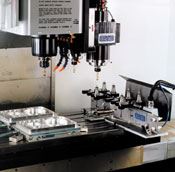Automatic Toolchanger For Auxiliary Spindles
For many shops, machine tools designed and dedicated to high speed milling are too expensive or too limited in productive capacity to justify. One approach around this constraint has been to mount an auxiliary spindle alongside the main spindle on a standard vertical machining center.
For many shops, machine tools designed and dedicated to high speed milling are too expensive or too limited in productive capacity to justify. One approach around this constraint has been to mount an auxiliary spindle alongside the main spindle on a standard vertical machining center. The auxiliary spindle provides high spindle speeds but lower horsepower, suitable for the light cuts at high feed rates that typically characterize high speed machining. The main spindle continues to handle roughing operations, where slower spindle speeds and high torque cutting are appropriate.
IBAG North America has a new wrinkle to this approach—two new wrinkles, as a matter of fact. One is to add a second auxiliary spindle and mount both on the main spindle. The other is to provide a toolchanger, giving the auxiliary spindles the level of flexibility and automation associated with the automatic toolchanger that serves the main spindle. The company is currently demonstrating this system on a Haas VF4 vertical machining center, which is being used by an electronics firm to produce aluminum micowave components.
Twin IBAG HF100-A45CF spindles are attached to the side of the spindle column, one behind the other. These spindles are designed for top speeds of 40,000 rpm. Each is rated at 10 hp. The add-on spindles ride on individual positioning slides, allowing the spindles to be placed in either working or resting (out of the way) positions. These spindles are manually moved in or out of the working position. Both can be moved into the resting position when the main spindle, a 15,000- rpm model on the VF4, is operating. Likewise, one or both of the auxiliary spindles can be moved into the working position.
Running both auxiliary spindles at once allows two workpieces to be machined at the same time, for twice the productivity of single spindle operation. For larger workpieces, only one spindle needs to be engaged.
The automatic toolchanger represents even more original thinking about high speed machining. This toolchanger is clamped to the table of the machine with bolts in the T-slots, but it can be removed easily to accommodate larger workpieces. The operator enters the desired spindle speed into a programmable terminal for each tool. By utilizing a custom macro in the Haas CNC, the machine will pick up the correct IBAG tool to be utilized next, and then will deposit the previous tool into the proper pocket in the IBAG toolchanger magazine. Four tools for each spindle can be stored in the toolchanger. The magazine also has a cover to protect the toolholders from chips and coolant. Programming only two lines of code in the standard part program performs all IBAG automatic tool change operations.
The IBAG spindle supply unit uses a central cooling system to remove heat from the spindles. Oil-air lubrication provides oil mist to the hybrid ceramic bearings, and two individual high frequency drives provide power for the spindle motors. According to developers, the system self-monitors all subsystems to ensure that the proper spindle operating conditions exist. If any alarm conditions occur, the Haas CNC is instructed to stop all feeds and inform the operator. A large LCD display indicates the cause of the alarm and displays troubleshooting information.
As IBAG representatives point out, utilizing a standard Haas machining center and adding the auxiliary spindles provides a unique and capable machine that can be delivered without the added expense typically incurred with a special machine design.
Read Next
The Cut Scene: The Finer Details of Large-Format Machining
Small details and features can have an outsized impact on large parts, such as Barbco’s collapsible utility drill head.
Read More3 Mistakes That Cause CNC Programs to Fail
Despite enhancements to manufacturing technology, there are still issues today that can cause programs to fail. These failures can cause lost time, scrapped parts, damaged machines and even injured operators.
Read More









.png;maxWidth=300;quality=90)













